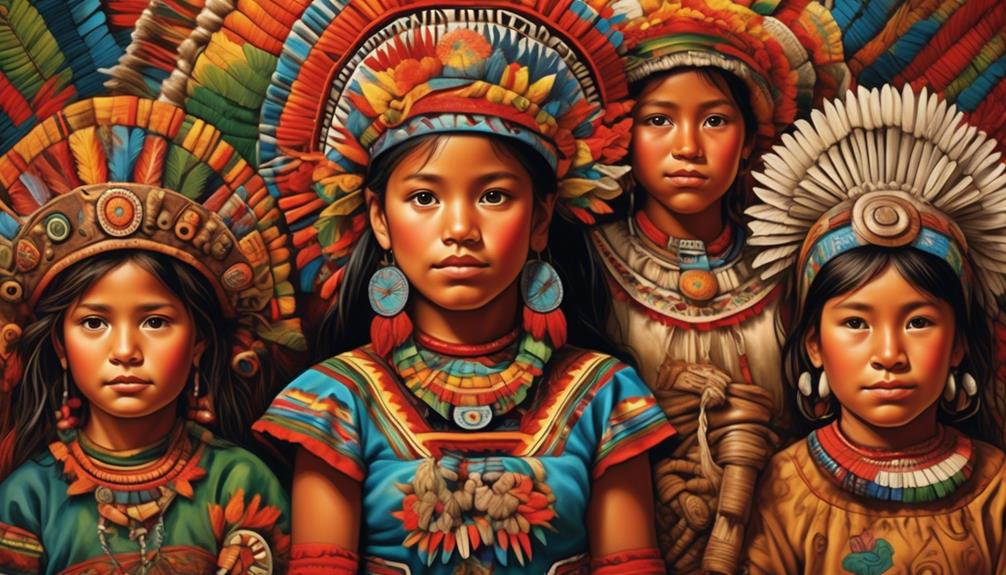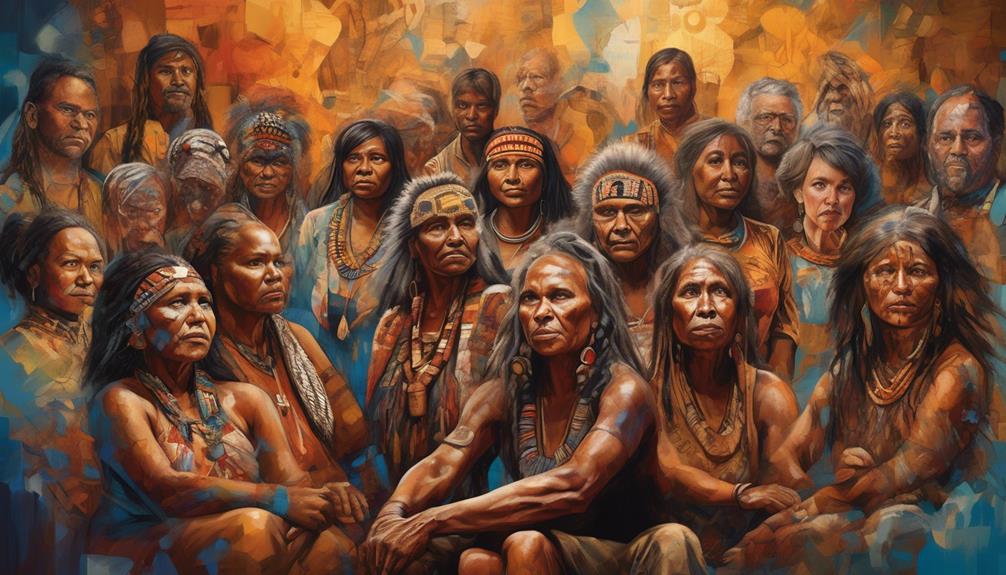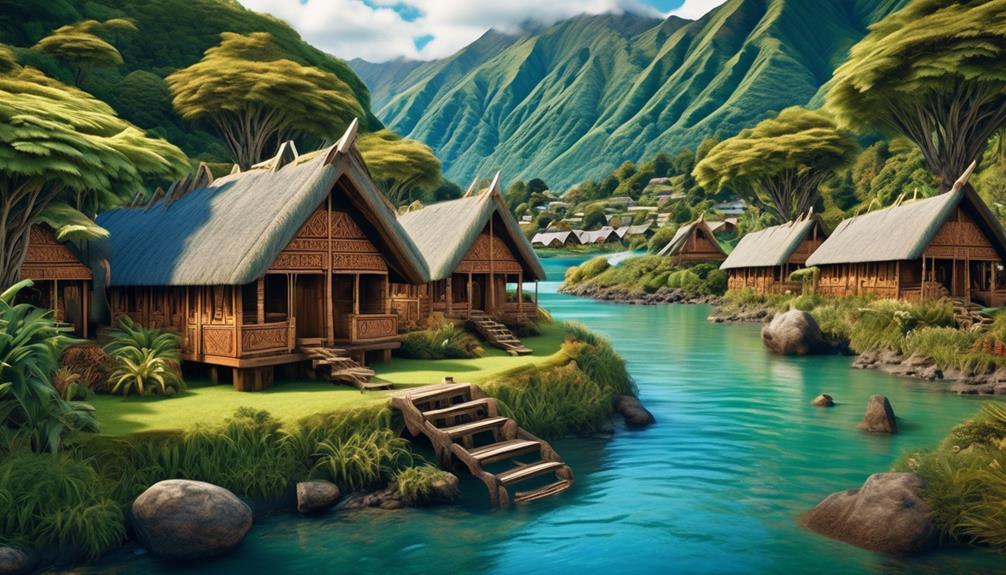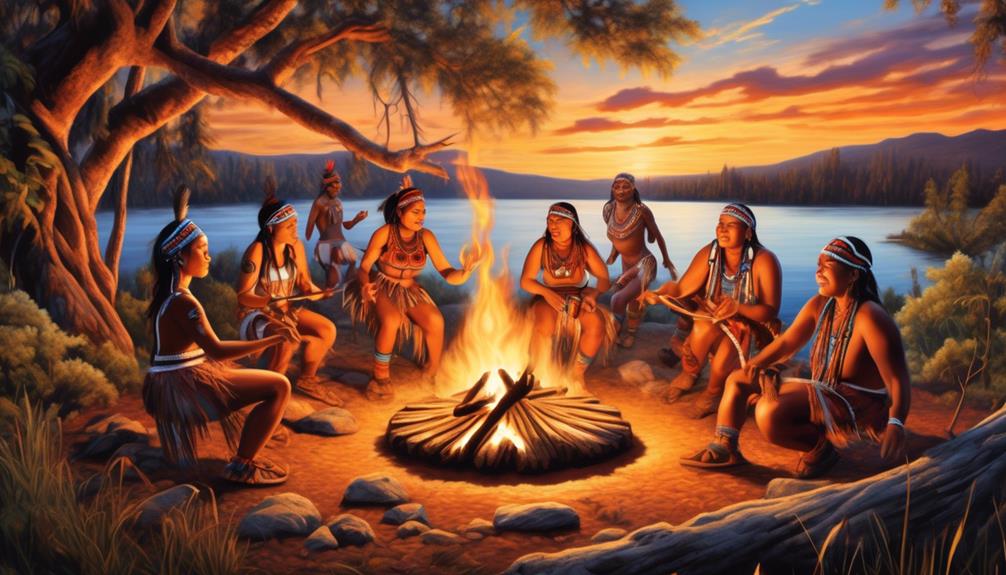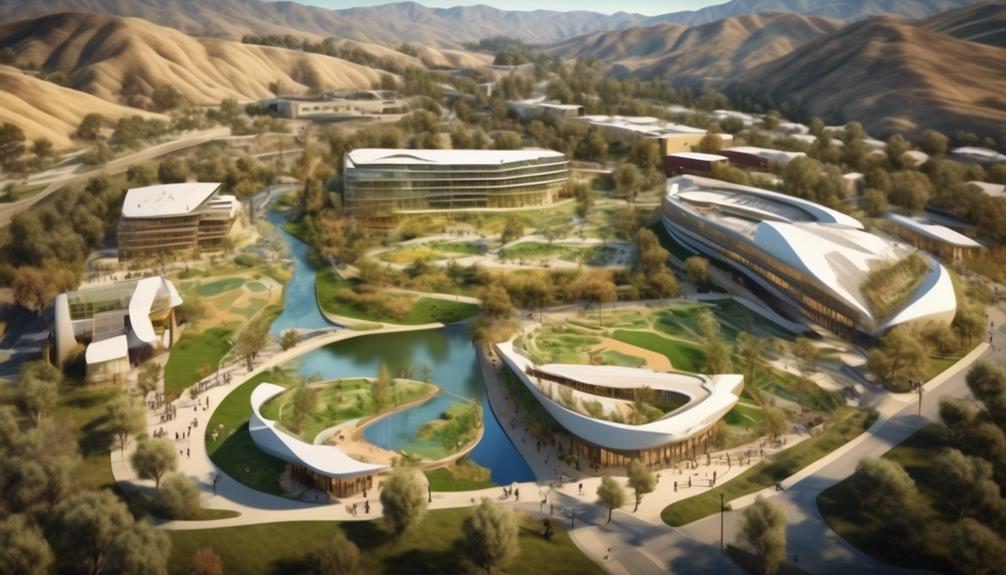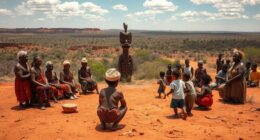Have you ever considered the diverse and captivating history of the indigenous peoples of Mexico?
The land we now know as Mexico was once home to a multitude of vibrant civilizations, each with its own unique customs, languages, and traditions.
From the enigmatic Olmec civilization to the majestic Aztec empire, the tapestry of indigenous cultures in Mexico is as fascinating as it is complex.
But who were these peoples, and what legacies have they left behind?
Let's uncover the remarkable stories of resilience, innovation, and heritage that have shaped the indigenous peoples of Mexico.
Key Takeaways
- The Olmec civilization played a significant role in influencing the development of Mesoamerican civilizations.
- The Maya civilization made remarkable advancements in various fields, including architecture, mathematics, astronomy, and hieroglyphic writing.
- The Aztec Empire was known for its advanced knowledge of engineering and architecture, as well as its notable religious practices.
- The Zapotec culture has a rich history and focuses on preserving their language and traditions, while also showcasing their connection to the land and nature through their artwork and rituals.
- The Mixtec society had sophisticated trade networks and contributed to the diverse indigenous cultures in Mexico through their flourishing art scene and the production of various goods.
Olmec Civilization
The Olmec Civilization, which emerged around 1400 BCE, played a significant role in the development of Mesoamerican cultures. Their influence on trade and art was particularly noteworthy.
The Olmecs were the first major civilization in Mexico and are often regarded as the mother culture of Mesoamerica. Their trade networks extended for hundreds of miles, allowing for the exchange of goods, ideas, and cultural practices. This facilitated the spread of Olmec art, which is characterized by colossal heads, intricate jade carvings, and unique pottery.
The colossal heads, in particular, are iconic representations of Olmec art and are believed to depict rulers or significant figures. Their sophisticated artistry and skilled craftsmanship reflect the Olmecs' advanced cultural and religious practices.
The trade networks not only allowed for the distribution of their art but also contributed to the spread of their cultural influence throughout the region. The Olmecs' artistic and trade achievements laid a foundation for the flourishing Mesoamerican civilizations that followed.
Maya Civilization
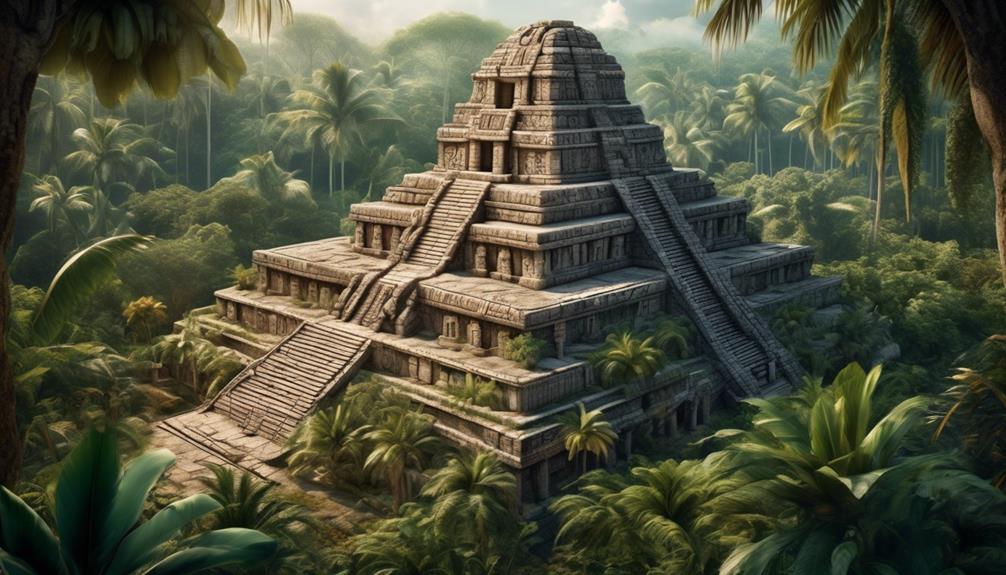
Emerging around 2000 BCE, the Maya Civilization thrived in present-day Mexico, Guatemala, Belize, Honduras, and El Salvador, exhibiting remarkable advancements in architecture, mathematics, astronomy, and hieroglyphic writing.
The Maya's architectural marvels, such as the iconic stepped pyramids like El Castillo at Chichen Itza, displayed their advanced knowledge of engineering and design. Their intricate city layouts and ceremonial centers also reflected their sophisticated urban planning.
The Mayan calendar, with its complex interlocking cycles, demonstrates their deep understanding of astronomy and mathematics, enabling them to make accurate predictions of celestial events. Furthermore, the Maya's astronomical observations allowed them to develop a comprehensive understanding of the movements of celestial bodies.
- The intricate designs of Maya architecture reflect their advanced engineering and mathematical knowledge.
- The Mayan calendar's interlocking cycles demonstrate a sophisticated understanding of astronomy and mathematics.
- The Maya's accurate predictions of celestial events showcase their advanced astronomical knowledge.
- El Castillo at Chichen Itza is a testament to the Maya's architectural prowess.
- The Maya's urban planning and ceremonial centers highlight their sophisticated city layouts.
Aztec Empire
At the height of its power, the Aztec Empire was known for its impressive capital city of Tenochtitlan, strategically built on an island in Lake Texcoco. The Aztecs were renowned for their advanced knowledge of engineering and architecture, exemplified by the intricate system of causeways and canals that connected the city to the mainland.
The empire's expansion was driven by a complex combination of military conquest, alliances, and tribute systems, allowing them to amass wealth and exert influence over a vast territory. This expansion also facilitated the spread of Aztec religion and culture, which played a central role in shaping the empire's societal structure.
The Aztec society was hierarchical, with a ruling class of nobles, skilled artisans, and a large slave population. Their religious beliefs permeated every aspect of life, reflected in their grand temples and sacrificial rituals. The grandeur of Aztec architecture, such as the Templo Mayor, stands as a testament to their advanced construction techniques and artistic expression.
The legacy of the Aztec Empire continues to captivate and intrigue scholars and enthusiasts alike, offering a window into a rich and complex civilization.
Zapotec Culture
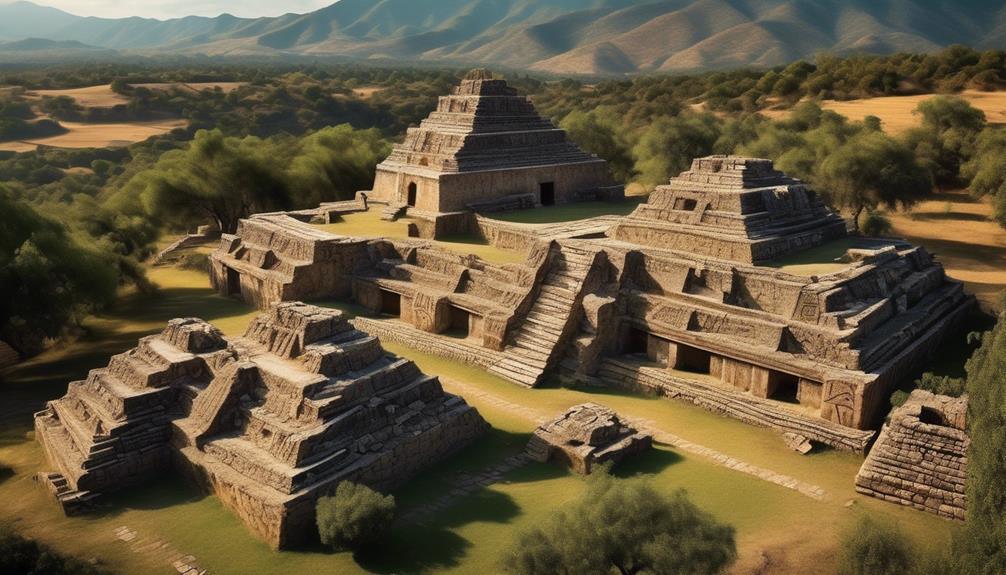
With a rich history dating back over two thousand years, Zapotec culture has made significant contributions to the cultural tapestry of Mexico. The Zapotec people have a long-standing tradition of artistic expression, particularly in the form of intricate pottery and intricate weavings.
Zapotec traditions are deeply rooted in their connection to the land and nature, with agricultural practices playing a central role in their customs and beliefs. This reverence for nature is reflected in their artwork and rituals, which often honor the earth and its cycles.
Oaxacan influence can be seen in the vibrant celebrations and festivals that are an integral part of Zapotec culture. These events showcase the rich tapestry of Zapotec traditions, including traditional music, dance, and cuisine.
The Zapotec language, still spoken by a significant portion of the population, is a testament to the resilience of their cultural heritage. Efforts to preserve and promote the Zapotec language are ongoing, ensuring that future generations can continue to engage with their rich linguistic traditions.
The architectural marvel of Monte Albán stands as a testament to the engineering and astronomical knowledge of the Zapotec people, showcasing their advanced understanding of urban planning and celestial phenomena. This ancient city serves as a living testament to the ingenuity and sophistication of Zapotec civilization.
Mixtec Society
The rich tapestry of indigenous cultures in Mexico extends beyond Zapotec traditions to encompass the intricate and vibrant society of the Mixtec people.
Mixtec society was characterized by a sophisticated system of trade and a remarkable tradition of art. The Mixtecs were adept traders, known for their extensive networks that connected various regions. They engaged in long-distance trade, exchanging goods such as cacao, salt, textiles, and ceramics. This commercial activity facilitated cultural exchange and the dissemination of artistic techniques and styles.
Mixtec art flourished, showcasing a high level of skill and creativity. Their artisans produced exquisite codices, intricate gold jewelry, and finely crafted ceramics. These works of art often depicted historical events, genealogies, and religious beliefs, providing valuable insights into Mixtec society and worldview. The Mixtecs also excelled in metallurgy, creating intricate gold ornaments and jewelry that reflected their advanced craftsmanship.
The combination of their thriving trade networks and impressive artistic production demonstrates the sophistication and cultural richness of the Mixtec society, contributing to the diverse tapestry of indigenous cultures that shaped Mexico's history.
Frequently Asked Questions
What Were the Trade Routes and Connections Between the Olmec, Maya, Aztec, Zapotec, and Mixtec Civilizations?
Trade routes and connections between the Olmec, Maya, Aztec, Zapotec, and Mixtec civilizations facilitated cultural exchange and economic relationships.
These networks allowed for the exchange of goods, ideas, and technologies, contributing to the development and interconnectedness of these societies.
The intricate web of trade routes not only facilitated economic prosperity but also fostered a rich exchange of cultural practices and knowledge among these ancient civilizations.
How Did the Indigenous Peoples of Mexico Interact With and Influence Other Mesoamerican Cultures Such as the Toltecs and the Teotihuacan?
We can see the interactions, influences, exchange, and adaptation among the indigenous peoples of Mexico and other Mesoamerican cultures, such as the Toltecs and the Teotihuacan, through archaeological evidence, historical accounts, and cultural artifacts.
These interactions shaped the development of trade, technology, religious practices, and political systems, leading to a rich tapestry of interconnected societies.
The exchange of goods, ideas, and traditions fostered a dynamic environment of cultural diversity and innovation.
What Were the Religious Beliefs and Practices of the Indigenous Peoples of Mexico and How Did They Evolve Over Time?
Our research reveals the fascinating evolution of religious beliefs and practices among the indigenous peoples of Mexico.
Over time, these beliefs have undergone significant transformations, reflecting the rich cultural and historical tapestry of the region.
The intricate and diverse religious traditions have shaped the spiritual landscape, offering valuable insights into the complex interplay between faith, culture, and societal development.
What Were the Social and Political Structures of the Indigenous Societies and How Did They Impact the Daily Lives of the People?
Social structures and political impact were integral to the daily life of indigenous societies in Mexico. Trade connections and cultural influence shaped their interactions. Religious evolution and lesser known contributions also played a significant role.
These factors varied among the diverse indigenous groups, each with their own unique societal organization and governance. Understanding these structures is crucial to comprehending the rich history and heritage of the indigenous peoples of Mexico.
What Are Some Lesser-Known Indigenous Groups in Mexico and What Were Their Contributions to the Overall History and Culture of the Region?
Sure, there are several lesser-known indigenous groups in Mexico that have made significant contributions to the region's history and culture.
These groups have had a profound impact through their cultural influences and trade connections.
Understanding the unique perspectives and experiences of these lesser-known groups provides a more comprehensive understanding of Mexico's rich indigenous heritage.
Their contributions have shaped the diverse and vibrant tapestry of Mexico's cultural history.
Conclusion
In conclusion, the indigenous peoples of Mexico have a rich and diverse history, with civilizations like the Olmec, Maya, Aztec, Zapotec, and Mixtec contributing to the country's cultural heritage.
It's fascinating to note that Mexico is home to over 68 indigenous languages, demonstrating the incredible linguistic diversity among these groups.
Their contributions to art, architecture, agriculture, and astronomy have left a lasting impact on Mexican society.
